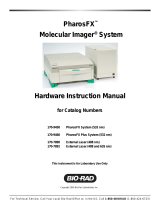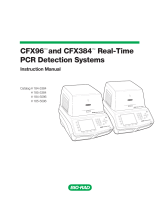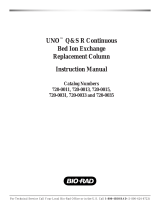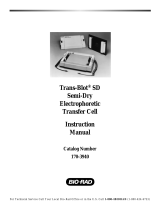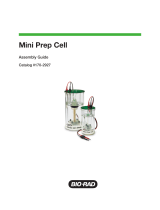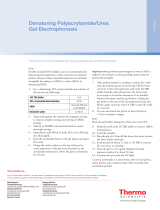Page is loading ...

THE DCODE
™
UNIVERSAL
MUTATION
DETECTION SYSTEM
Catalog Numbers
170-9080 through 170-9104
For Technical Service Call Your Local Bio-Rad Office or in the U.S. Call 1-800-4BIORAD (1-800-424-6723)

Warranty
The DCode universal mutation detection system lid, tanks, casting stand, gradient mixer,
and accessories are warranted against defects in materials and workmanship for 1 year. If any
defects occur during this period, Bio-Rad will repair or replace the defective parts at our
discretion, without charge. The following defects, however, are excluded:
1. Defects caused by improper operation.
2. Repair or modification done by anyone other than Bio-Rad Laboratories or an authorized agent.
3. Damage caused by substituting alternative parts.
4. Use of fittings or spare parts supplied by anyone other than Bio-Rad Laboratories.
5. Damage caused by accident or misuse.
6. Damage caused by disaster.
7. Corrosion caused by improper solvent
†
or sample.
This warranty does not apply to parts listed below:
• Fuses
• Glass plates
• Electrodes
For any inquiry or request for repair service, contact Bio-Rad Laboratories. Inform
Bio-Rad of the model and serial number of your instrument.
Important: This Bio-Rad instrument is designed and certified to meet EN61010-1* safety
standards. Certified products are safe to use when operated in accordance with the instruction
manual. This instrument should not be modified or altered in any way. Alteration will:
• Void the manufacturer’s warranty
• Void the EN61010-1 safety certification
• Create a potential safety hazard
Bio-Rad Laboratories is not responsible for any injury or damage caused by the use of this
instrument for purposes other than those for which it is intended, or by modifications of the
instrument not performed by Bio-Rad Laboratories or an authorized agent.
The Model 475 Gradient Delivery System is covered by U.S. patent number 5,540,498.
Practice of PCR is covered by U.S. patent numbers 4,683,195; 4,683,202; 4,899,818
issued to Cetus Corporation, which is a subsidiary of Hoffmann-LaRoche Molecular Systems,
Inc. Purchase of any of Bio-Rad’s PCR-related products does not convey a license to use the
PCR process covered by these patents. To perform PCR, the user of these products must
obtain a license.
© 1996 Bio-Rad Laboratories
All Rights Reserved
† The DCode system tank is not compatible with chlorinated hydrocarbons (e.g., chloroform), aromatic hydrocarbons (e.g., toluene,
benzene), or acetone. Use of organic solvents voids all warranties.
* EN61010-1 is an internationally accepted electrical safety standard for laboratory instruments.

Table of Contents
Section 1 General Safety Information .......................................................................1
1.1 Caution Symbols........................................................................................................1
1.2 Precautions During Set-up .........................................................................................1
1.3 Precautions During a Run ..........................................................................................1
1.4 Precautions After a Run .............................................................................................2
1.5 Safety..........................................................................................................................2
Section 2 Introduction..................................................................................................2
2.1 Introduction to Mutation Detection Technology.......................................................2
Section 3 Product Description.....................................................................................2
3.1 Packing List................................................................................................................2
3.2 System Components and Accessories .......................................................................5
Section 4 Denaturing Gel Electrophoresis (DGGE, CDGE, TTGE)....................11
4.1 Introduction to Denaturing Gradient Gel Electrophoresis (DGGE) .......................11
Reagent Preparation .................................................................................................13
Gel Volumes.............................................................................................................15
Sample Preparation ..................................................................................................16
Temperature Controller............................................................................................16
Preheating the Running Buffer ................................................................................17
Assembling the Perpendicular Gradient Gel Sandwich..........................................17
Casting Perpendicular Gradient Gels.......................................................................21
Assembling the Parallel Gradient Gel Sandwich ....................................................23
Casting Parallel Gradient Gels.................................................................................25
4.2 Introduction to Constant Denaturing Gel Electrophoresis (CDGE) .......................27
Reagent Preparation .................................................................................................28
Gel Volumes.............................................................................................................30
Sample Preparation ..................................................................................................30
Temperature Controller............................................................................................31
Preheating the Running Buffer ................................................................................31
Assembling the CDGE Gel Sandwich.....................................................................31
Casting CDGE Gels .................................................................................................33
4.3 Introduction to Temporal Temperature Gradient Gel Electrophoresis (TTGE).....34
Calculating the Run Parameters...............................................................................35
Reagent Preparation .................................................................................................36
Gel Volumes.............................................................................................................38
Sample Preparation ..................................................................................................38
Temperature Controller............................................................................................38
Preheating the Running Buffer ................................................................................38
Assembling the TTGE Gel Sandwich......................................................................39
Casting TTGE Gels..................................................................................................40
Section 5 Heteroduplex Analysis...............................................................................41
5.1 Introduction to Heteroduplex Analysis....................................................................41
5.2 Reagent Preparation .................................................................................................42
5.3 Gel Volumes.............................................................................................................44
5.4 Sample Preparation ..................................................................................................45
5.5 Temperature Controller............................................................................................45
5.6 Adding the Running Buffer......................................................................................45
5.7 Assembling the Heteroduplex Analysis Gel Sandwich...........................................46
5.8 Casting Heteroduplex Analysis Gels.......................................................................47

Section 6 Single-Stranded Conformational Polymorphism (SSCP).....................48
6.1 Introduction to SSCP ...............................................................................................48
6.2 Reagent Preparation ................................................................................................50
6.3 Gel Volumes.............................................................................................................52
6.4 Sample Preparation .................................................................................................52
6.5 Temperature Controller............................................................................................52
6.6 Cooling the Running Buffer and Chiller Settings ...................................................53
6.7 Assembling the SSCP Gel Sandwich ......................................................................53
6.8 Casting SSCP Gels...................................................................................................55
Section 7 Protein Truncation Test (PTT).................................................................56
7.1 Introduction to PTT .................................................................................................56
7.2 Reagent Preparation ................................................................................................57
7.3 Gel Volumes.............................................................................................................59
7.4 Sample Preparation ..................................................................................................59
7.5 Temperature Controller............................................................................................59
7.6 Adding the Running Buffer......................................................................................60
7.7 Assembling the PTT Gel Sandwich.........................................................................60
7.8 Casting PTT Gels.....................................................................................................62
Section 8 Electrophoresis...........................................................................................63
8.1 Assembling the Upper Buffer Chamber..................................................................63
8.2 Sample Loading........................................................................................................65
8.3 Running the Gel .......................................................................................................65
8.4 Removing the Gel.....................................................................................................67
8.5 Staining and Photographing the Gel........................................................................68
Section 9 Troubleshooting Guide .............................................................................69
9.1 Equipment ...............................................................................................................69
9.2 Applications..............................................................................................................71
Section 10 Specifications..............................................................................................75
Section 11 Maintenance ...............................................................................................76
Section 12 References...................................................................................................76
Section 13 Instruments and Reagents for Mutation Detection Electrophoresis ...77

Section 1
General Safety Information
1.1 Caution Symbols
Read the manual before using the DCode system. For technical assistance, contact your local
Bio-Rad Office or in the U.S., call Technical Services at 1-800-4BIORAD (1-800-424-6723).
DC power to the DCode system is supplied by an external DC voltage power supply. This power
supply must be ground isolated so that the DC voltage output floats with respect to ground. All
Bio-Rad power supplies meet this important safety requirement. Regardless of which power sup-
ply is used, the maximum specified operating parameters for the system are:
• Maximum voltage limit 500 VDC
• Maximum power limit 50 watts
AC current for controlling temperature to the system, and DC current for electrophoresis,
provided by the external power supply, enter the unit through the lid assembly, which provides
a safety interlock. DC current to the cell is broken when the lid is removed. Do not attempt to
circumvent this safety interlock. Always disconnect the AC cord from the unit and the cord
from the DC power supply before removing the lid, or when working with the cell.
Definition of Symbols
Caution, risk of electric shock.
Caution
Caution, hot surface.
1.2 Precautions During Set-up
• Do not use near flammable materials.
• Always inspect the DCode system for damaged components before use.
• Always place the DCode system on a level bench-top.
• Always place the lid assembly on the buffer tank with the AC and DC power cords
disconnected.
• Always connect the system to the correct AC and DC power sources.
1.3 Precautions During a Run
• Do not run the pump when it is dry. Always add buffer to the “Fill” line when
pre-chilling and/or preheating the buffer; always keep the buffer below “Max” level
during electrophoresis.
• Do not touch any wet surface unless all the electrical sources are disconnected.
• Do not put anything on the top surface of the DCode system module.
1

1.4 Precautions After a Run
• Always turn off power switches and unplug all cables to DC and AC sources. Allow the
heater tube to cool down (approximately 1 minute) before removing it from the tank.
The ceramic tube may be very hot after shut-down. Do not touch the ceramic tube after
turning off the power.
• Do not cool the hot ceramic tube in cool liquids.
• Always store the electrophoresis/temperature control module on the aluminum DCode
lid stand for maximum stability. Caution: the heater tube may be hot after use
1.5 Safety
This instrument is intended for laboratory use only
This product conforms to the “Class A” standards for electromagnetic emissions intend-
ed for laboratory equipment applications. It is possible that emissions from this product may
interfere with some sensitive appliances when placed nearby or in the same circuit as those
appliances. The user should be aware of this potential and take appropriate measures to avoid
interference.
Section 2
Introduction
2.1 Introduction to Mutation Detection Technology
Detecting single base mutations is of utmost importance in the field of molecular genetics.
Screening for deletions, insertions, and base substitutions in genes was initially done by Southern
blotting. Many techniques have been developed to analyze the presence of mutations in a DNA
target. The most common methods include: Single-Strand Conformational Polymorphism
1
(SSCP), Denaturing Gradient Gel Electrophoresis
2
(DGGE), carbodiimide
3
(CDI), Chemical
Cleavage of Mismatch
4
(CCM), RNase cleavage,
5
Heteroduplex analysis,
6
and the Protein
Truncation Test
7
(PTT). A new technique for mutation detection is Temporal Temperature
Gradient Gel Electrophoresis
8
(TTGE). Bio-Rad reduced this technique to a simple, reproducible
method on the DCode system. TTGE uses a polyacrylamide gel containing a constant concen-
tration of urea. During electrophoresis, the temperature is increased gradually and uniformly. The
result is a linear temperature gradient over the course of the electrophoresis run. Many labs used
combination of methods to maximize mutation detection efficiency.
The DCode system is a vertical electrophoresis instrument for the detection of gene
mutations. The DCode system can be used to perform any vertical gel-based mutation
detection method. The system is optimized for DGGE, CDGE, TTGE, SSCP, PTT and
Heteroduplex Analysis. Some of the advantages of the DCode system include uniform buffer
temperature around the gel, buffer circulation, buffer temperature runs from 5 to 70 °C and a
modular design to allow customization.
Section 3
Product Description
3.1 Packing List
The DCode system is shipped with the following components. If items are missing or
damaged, contact your local Bio-Rad office.
2

The DCode System for DGGE (10 cm and 16 cm systems)
Item Quantity
Instruction manual 1
Warranty card (please complete and return) 1
Electrophoresis/temperature control module 1
Electrophoresis tank 1
Casting stand with sponges 1
Sandwich core 1
DCode lid stand 1
16 cm glass plates (16 cm system) 2 sets
10 cm glass plates (10 cm system) 2 sets
Sandwich clamps 2 sets
Spacers, grooved, 1 mm 2 sets
Middle spacer, 1 mm (10 cm system) 2
Prep comb, 1 well, 1 mm (16 cm system) 2
Prep comb, 2 well, 1 mm (10 cm system) 2
16-well comb, 1 mm 1
Comb gasket for 0.75 & 1 mm spacers 1
Comb gasket holder 1
Model 475 gradient former 1
Syringes: 10 ml, 30 ml 2 each
Tubing 3 feet
Luer couplings 4
Luer syringe locks 2
Syringe sleeves 4
Syringe cap screws 2
Y-fitting 5
Control reagent kit for DGGE, CDGE, TTGE 1
DCode System for CDGE
Item Quantity
Instruction manual 1
Warranty card (please complete and return) 1
Electrophoresis/temperature control module 1
Electrophoresis tank 1
Casting stand with sponges 1
Sandwich core 1
DCode lid stand 1
Glass plates, 16 cm 2 sets
Sandwich clamps 2 sets
Spacers, 1 mm 2 sets
20-well combs, 1 mm 2
Control reagent kit for DGGE, CDGE, TTGE 1
3

DCode System for TTGE
Item Quantity
Instruction manual 1
Warranty card (please complete and return) 1
Electrophoresis/temperature control module 1
Electrophoresis tank 1
Casting stand with sponges 1
Sandwich core 1
DCode lid stand 1
Glass plates, 16 cm 2 sets
Sandwich clamps 2 sets
Spacers, 1 mm 2 sets
20-well combs, 1 mm 2
Control reagent kit for DGGE, CDGE, TTGE 1
DCode System for SSCP
Item Quantity
Instruction manual 1
Warranty card (please complete and return) 1
Electrophoresis/temperature control module 1
Electrophoresis cooling tank 1
Casting stand with sponges 1
Sandwich core 1
DCode lid stand 1
Sandwich clamps 2 sets
Glass plates, 20 cm 2 sets
Spacers, 0.75 mm 2 sets
20-well combs, 0.75 mm 2
Control reagent kit for SSCP 1
DCode System for Heteroduplex Analysis
Item Quantity
Instruction manual 1
Warranty card (please complete and return) 1
Electrophoresis/temperature control module 1
Electrophoresis tank 1
Casting stand with sponges 1
Sandwich core 1
DCode lid stand 1
Sandwich clamps 2 sets
Glass plates, 20 cm 2 sets
Spacers, 0.75 mm 2 sets
20-well combs, 0.75 mm 2
Control reagent kit for Heteroduplex Analysis 1
4

DCode System for Protein Truncation Test
Item Quantity
Instruction manual 1
Warranty card (please complete and return) 1
Electrophoresis/temperature control module 1
Electrophoresis tank 1
Casting stand with sponges 1
Sandwich core 1
DCode lid stand 1
Sandwich clamps 2 sets
Glass plates, 20 cm 2 sets
Spacers, 1 mm 2 sets
20-well comb, 1 mm 2
3.2 System Components and Accessories
Fig. 3.1. The DCode system.
System Components
and Accessories Description
Electrophoresis Tank The electrophoresis tank is a reservoir for the running buffer.
Electrophoresis Cooling Tank The electrophoresis cooling tank has two ceramic cooling
(SSCP only) fingers inside the electrophoresis tank (Figure 3.2). Two
quick-release connectors are connected to an external
chiller to chill the running buffer. The electrophoresis
cooling tank should not be used for heated buffer runs
(i.e., DGGE, CDGE or TTGE).
Fig. 3.2. Electrophoresis cooling tank.
5
Model 475
Gradient Former
Electrophoresis/temperature
control module
Casting stand with
perpendicular assembly
Electrophoresis tank
Core
Casting
stand
Ceramic
cooling
fingers

Fig. 3.3. Electrophoresis/Temperature Control Module.
System Components
and Accessories Description
Electrophoresis/Temperature The control module contains the heater, stirrer, pump, and
Control Module electrophoresis leads to operate the DCode system (Figure 3.3).
Combined with the lower buffer tank, the control module acts
to fully enclose the system. The control module should be
placed so that the tip of the stirring bar fits inside the support
hole of the tank. The clear loading lid is a removable part that
contains four banana jacks which function as a safety interlock.
It should be left in place at all times except while loading samples.
Core The sandwich core holds one gel assembly on each side
(Figure 3.4). When attached, each gel assembly forms one side
of the upper buffer chamber. The inner plate is clamped against
a rubber gasket on the core to provide a greaseless seal for the
upper buffer chamber.
Fig. 3.4. Core
6
Buffer level
interlock
Temperature
sensor
Buffer
recirculation pump
Buffer
recirculation port
Ceramic heater
Stirrer
Temperature
controller

Casting Stand The casting stand holds the gel sandwich upright while
casting a gel (Figure 3.5). With the cam levers engaged,
the sponge seals the bottom of the gel while the acrylamide
polymerizes.
Fig. 3.5. Casting Stand.
Sandwich Clamps The sandwich clamps consist of a single screw mechanism
which makes assembly, alignment, and disassembly of the
gel sandwich an effortless task. The clamps exert an even
pressure over the entire length of the glass plates. A set
consists of a left and right clamp.
Alignment Card The alignment card simplifies sandwich assembly by keeping
the spacers in the correct position.
Comb Gasket Holder The comb gasket holder holds the comb gasket that prevents
(DGGE only) leakage of acrylamide during gel casting (Figure 3.6). The
front of the holder has two screws which are used to secure
the comb gasket against the glass plate. The top of the comb
gasket holder also has two tilt rod screws which control the
position of the tilt rod during gel casting. The opposite side of
the comb gasket holder has two vent ports. There are two sizes
of comb gasket holder: a 1 mm size for 1 mm and 0.75 mm
spacer sets and a 1.5 mm size for the 1.5 mm spacer set.
Fig. 3.6. Comb gasket holder.
7
Notched step
Gasket holder
Comb gasket screws
Tilt rod

Stopcocks (DGGE only) The gel solution is introduced via the stopcock at the inlet
port on the sandwich clamp when casting a perpendicular
gel (Figure 3.7).
Fig. 3.7. Stopcock
Comb and Spacer Set The 7.5 x 10 cm gel format consist of two “mirror image”
(DGGE only) spacers, one middle spacer and a dual prep comb for two
7.5 x 10 cm gels (Figure 3.8). The spacers have a groove
and injection port hole for casting. The middle spacer
between the two gels fits into the middle notch of the dual
comb and allows the air to escape through the comb gasket
holder vent port. The 16 x 16 cm gel format consist of two
different spacers, one with the groove and injection port hole
for casting and one with a short groove toward the injection
port hole for air to escape. A single prep comb without a
middle spacer is provided with the 16 x 16 cm gel format.
Fig. 3.8. Dual prep comb and spacer set for two 7.5 x 10 cm gels.
Comb and Spacer Set Different types of combs and spacers are provided with the
different DCode systems. Spacer lengths are 10 cm, 16 cm or
20 cm, with a thickness of 0.75 or 1.0 mm. Combs come
with 16 or 20 wells and a thickness of 0.75 or 1.0 mm.
8
Inlet fitting
Injection port holes
groove

Fig. 3.9. Pressure clamp.
Pressure Clamp The pressure clamp provides consistent pressure to the
(DGGE only) comb gasket before securing it to the plate assembly to
provide a seal (Figure 3.9).
DCode Lid Stand The DCode lid stand provides a stand when the elec-
trophoresis/temperature control module (lid) is not in use. The
stand must be used to properly support and protect the lid
components when the lid is not on the electrophoresis tank.
Fig. 3.10. Model 475 Gradient Delivery System.
9
Gasket holder
Comb gasket
Air vent
Pressure clamp
Pressure
clamp screw
Large glass plate
Small glass plate
Luer fitting
VOLUME
10 ML SYRINGE
4
MODEL 475
GRADIENT DELIVERY
SYSTEM
THIS SIDE FOR
HIGH DENSITY SOLUTION
(BOTTOM FILLING)
LOW DENSITY SOLUTION
(TOP FILLING)
Syringe holder
DELIVER
Cam
Plunger cap screw
Plunger cap
Lever
Y-Fitting
Tubing
Syringe
Syringe sleeve
Syringe holder screw
Volume setting indicator
Volume adjustment screw
12 34 5 6 78 910
10
7
6
5
5 6

Model 475 System Components
Description (DGGE System only)
Syringe Two pairs each of 10 and 30 ml disposable syringes are
provided. The 10 ml syringes are for gel volumes less than
10 ml. The 30 ml syringes are for gel volumes greater than
10 ml. For proper gel casting, use matching syringe sizes.
Plunger Caps/Plunger Cap Screw There are two plunger caps, one for each syringe. The
plunger caps fit both the 10 and 30 ml syringes (Figure 3.11).
Lever Attachment Screw The lever attachment screw is on the plunger cap. This
screw fits into the groove of the lever and conducts the
driving force of the cam in dispensing the gel solution.
Syringe Sleeve One pair of syringe sleeves for each size syringe is provided
(Figure 3.12). The sleeve is a movable adaptor to mount the
syringe in the holder. The sleeve should conform to the
syringe. If the syringe is too tight or too loose, adjust the
sleeve by pushing or pulling.
Syringe Holder/ The syringe holder is next to the lever. It holds the syringe in
Syringe Holder Screw place and controls the delivery volume. The syringe is held
in the holder by tightening the holder screw against the sleeve.
Volume Adjustment Screw The volume adjustment screw is on both sides of the syringe
holder (Figure 3.10). It adjusts the holder to the desired
delivery volume.
Volume Setting Indicator The volume setting indicator is at the top corner of the syringe
holder nearest the volume setting numbers (Figure 3.10).
Lever The position of the lever is controlled by the rotation of
the cam (Figure 3.10). The lever must be in the vertical or
start position before use.
Tygon Tubing One length of Tygon
™
tubing is provided. Cut the tubing into
two 15.5 cm and one 9 cm lengths. The longer pieces are used
to transport the gel solution from the syringes into the Y-fitting.
The short piece will transport the gel solution from the
Y-fitting to the gel sandwich.
Y-Fitting The Y-fitting mixes the high and low density gel solutions
(Figure 3.13).
Luer Fitting/Coupling There are two luer fittings that fit both 10 and 30 ml syringes.
The fittings twist onto the syringe and connect to the Tygon
tubing on the other end. A luer coupling is used on one end
of the 9 cm tubing to connect it to the gel sandwich stopcock.
10
Fig. 3.11. Plunger Cap Fig. 3.12. Syringe sleeve Fig. 3.13. Y-Fitting
Lever
attachment
screw
Plunger cap
screw

Section 4
Denaturing Gel Electrophoresis (DGGE, CDGE, TTGE)
4.1 Introduction to Denaturing Gradient Gel Electrophoresis (DGGE)
Denaturing Gradient Gel Electrophoresis (DGGE) is an electrophoretic method to identify
single base changes in a segment of DNA. Separation techniques on which DGGE is based
were first described by Fischer and Lerman.
2
In a denaturing gradient acrylamide gel,
double-stranded DNA is subjected to an increasing denaturant environment and will melt in
discrete segments called "melting domains". The melting temperature (T
m
) of these domains is
sequence-specific. When the T
m
of the lowest melting domain is reached, the DNA will become
partially melted, creating branched molecules. Partial melting of the DNA reduces its mobility
in a polyacrylamide gel. Since the T
m
of a particular melting domain is sequence-specific, the
presence of a mutation will alter the melting profile of that DNA when compared to wild-type.
DNA containing mutations will encounter mobility shifts at different positions in the gel than the
wild-type. If the fragment completely denatures, then migration again becomes a function of
size (Figure 4.1).
Fig. 4.1. An example of DNA melting properties in a perpendicular denaturing gradient gel. At a
low concentration of denaturant, the DNA fragment remains double-stranded, but as the concentration of
denaturant increases, the DNA fragment begins to melt. Then, at very high concentrations of denaturant,
the DNA fragment can completely melt, creating two single strands.
In DGGE, the denaturing environment is created by a combination of uniform temperature,
typically between 50 and 65 °C and a linear denaturant gradient formed with urea and
formamide. A solution of 100% chemical denaturant consists of 7 M urea and 40% formamide.
The denaturing gradient may be formed perpendicular or parallel to the direction of
electrophoresis. A perpendicular gradient gel, in which the gradient is perpendicular to the
electric field, typically uses a broad denaturing gradient range, such as 0–100% or 20–70%.
2
In parallel DGGE, the denaturing gradient is parallel to the electric field, and the range of
denaturant is narrowed to allow better separation of fragments.
9
Examples of perpendicular
and parallel denaturing gradient gels with homoduplex and heteroduplex fragments are shown
in Figure 4.2.
11
Single strands
Double strand
Partially melted
“wild type”
Partially melted
“mutant”
*
Wild Type
Mutant
*
0%
100%
Denaturant
Electrophoresis
Double strand
Single strands
Denaturant
Wild Type
Mutant
100%0%
Partially melted
"wild type"
Partially melted
"mutant"
Electrophoresis

Fig. 4.2. A. Perpendicular denaturing gradient gel in which the denaturing gradient is perpendicular
to the electrophoresis direction. Mutant and wild-type alleles of exon 6 from the TP53 gene amplified from
primary breast carcinomas and separated by perpendicular DGGE (0–70% denaturant) run at 80 V for 2 hours
at 56 °C. The first two bands on the left are heteroduplexes and the other two bands are the homoduplexes.
B. Parallel denaturing gradient gel in which the denaturing gradient is parallel to the electrophoresis
direction. Mutant and wild-type alleles of exon 8 from the p53 gene separated by an 8% acrylamide:bis (37.5:1)
gel with a parallel gradient of 40–65% denaturant. The gel was run at 150 V for 2.5 hours at 60 °C in 1x TAE buffer.
Lane 1 contains the mutant fragment, lane 2 contains the wild-type fragment, lane 3 contains both the mutant
and wild-type fragments.
When running a denaturing gradient gel, both the mutant and wild-type DNA fragments
are run on the same gel. This way, mutations are detected by differential migration of mutant and
wild-type DNA. The mutant and wild-type fragments are typically amplified by the polymerase
chain reaction (PCR) to make enough DNA to load on the gel. Optimal resolution is attained
when the molecules do not completely denature and the region screened is in the lowest melting
domain. The addition of a 30–40 base pair GC clamp to one of the PCR primers insures that the
region screened is in the lower melting domain and that the DNA will remain partially
double-stranded.
34
An alternative to GC clamps is using psoralen derivative PCR primers called
ChemiClamp primers.
10
Because ChemiClamps covalently link the two DNA strands at one
end, they should not be used when isolating a DNA fragment which is going to be sequenced
from a gel. The size of the DNA fragments run on a denaturing gel can be as large as 1 kb in
length, but only the lower melting domains will be available for mutation analysis. For complete
analysis of fragments over 1 kb in length, more than one PCR reaction should be performed.
11
The thermodynamics of the transition of double-stranded to single-stranded DNA have
been described by a computer program developed by Lerman.
12
Bio-Rad offers a Macintosh
®
computer program, MacMelt
™
software, which calculates and graphs theoretical DNA melting
profiles. Melting profile programs can show regions of theoretical high and low melting domains
of a known sequence. Placement of primers and GC clamps can be optimized by analysis of
placement effect on the DNA melting profile.
The method of creating heteroduplex molecules helps in detecting homoduplex mutations.
This process is typically done when it is not originally possible to resolve a homoduplex
mutation. Analysis of heteroduplex molecules can, therefore, increase the sensitivity of DGGE.
Heteroduplexes can be formed by adding the wild-type and mutant template DNAs in the same
PCR reaction or by adding separate PCR products together, then denaturing and
allowing them to re-anneal. A heteroduplex has a mismatch in the double-strand causing a
distortion in its usual conformation; this has a destabilizing effect and causes the DNA strands
to denature at a lower concentration of denaturant (Figure 4.3). The heteroduplex bands always
migrate more slowly than the corresponding homoduplex bands under specific conditions.
12
AB
0%
40%
70%
65%

Fig. 4.3. An example of wild-type and mutant DNA fragments that were denatured and re-annealed
to generate four fragments: two heteroduplexes and two homoduplexes run on a parallel
denaturing gradient gel. The melting behavior of the heteroduplexes is altered so that they melt at a lower
denaturant concentration than the homoduplexes and can be visualized on a denaturing gradient gel.
Reagent Preparation
The concentration of denaturant to use varies for the sample being analyzed with the
DCode system. Typically a broad denaturing gradient range is used, such as 0–100% or
20–70%. The concentration of acrylamide can also vary, depending on the size of the fragment
analyzed. Both 0% and 100% denaturant should be made as stock solutions. A 100% denat-
urant is a mixture of 7 M urea and 40% deionized formamide. Reagents for casting and run-
ning a DGGE gel are included in the DCode Electrophoresis Reagent Kit for DGGE/CDGE,
catalog number 170-9032.
For different percent crosslinking, use the equation below to determine the amount of
Bis to add. The example stock solution below is for an acrylamide/bis ratio of 37.5:1.
40% Acrylamide/Bis (37.5:1)
Reagent Amount
Acrylamide 38.93 g
Bis-acrylamide 1.07 g
dH
2
O to 100.0 ml
Filter through a 0.45 µ filter and store at 4 °C.
13
Denature and reanneal
Wild Type DNA Mutant DNA
wt mut wt + mut
Homoduplexes
Heteroduplexes
Homoduplex
DNA
Heteroduplex
DNA
Wild-Type DNA
Mutant DNA
wt + mut
wt
20%
60%
mut
Heteroduplex
DNA
Homoduplex
DNA
Homoduplexes
Heteroduplexes
Denature and reanneal
Denaturant

Polyacrylamide gels are described by reference to two characteristics:
1) The total monomer concentration (%T)
2) The crosslinking monomer concentration (%C)
%T =
gm acrylamide + gm bis-acrylamide
x 100
Total Volume
%C =
gm bis-acrylamide
x 100
gm acrylamide + gm bis-acrylamide
50x TAE Buffer
Reagent Amount Final Concentration
Tris base 242.0 g 2 M
Acetic acid, glacial 57.1 ml 1 M
0.5 M EDTA, pH 8.0 100.0 ml 50 mM
dH
2
O to 1,000.0 ml
Mix. Autoclave for 20–30 minutes. Store at room temperature.
The table below provides the percentage acrylamide/bis needed for a particular size range.
Gel Percentage Base Pair Separation
6% 300–1000 bp
8% 200–400 bp
10% 100–300 bp
0% Denaturing Solution
6% Gel 8% Gel 10% Gel 12% Gel
40% Acrylamide/Bis 15 ml 20 ml 25 ml 30 ml
50x TAE buffer 2 ml 2 ml 2 ml 2 ml
dH
2
O 83 ml 78 ml 73 ml 68 ml
Total volume 100 ml 100 ml 100 ml 100 ml
Degas for 10–15 minutes. Filter through a 0.45 µ filter. Store at 4 °C in a brown bottle for
approximately 1 month.
100% Denaturing Solution
6% Gel 8% Gel 10% Gel 12% Gel
40% Acrylamide/Bis 15 ml 20 ml 25 ml 30 ml
50x TAE buffer 2 ml 2 ml 2 ml 2 ml
Formamide (deionized) 40 ml 40 ml 40 ml 40 ml
Urea 42 g 42 g 42 g 42 g
dH
2
O to 100 ml to 100 ml to 100 ml to 100 ml
Degas for 10–15 minutes. Filter through a 0.45 µ filter. Store at 4 °C in a brown bottle for
approximately 1 month. A 100% denaturant solution requires re-dissolving after storage. Place
the bottle in a warm bath and stir for faster results.
14

For denaturing solutions less than 100%, use the volumes for acrylamide, TAE and water
described above in the 100% Denaturing Solution. Use the amounts indicated below for urea
and formamide.
Denaturing Solution 10% 20% 30% 40% 50% 60% 70% 80% 90%
Formamide (ml) 4 8 12 16 20 24 28 32 36
Urea (g) 4.2 8.4 12.6 16.8 21 25.2 29.4 33.6 37.8
10% Ammonium Persulfate
Reagent Amount
Ammonium persulfate 0.1 g
dH
2
O 1.0 ml
Store at -20 °C for about a week.
DCode Dye Solution
Reagent Amount Final Concentration
Bromophenol blue 0.05 g 0.5%
Xylene cyanol 0.05 g 0.5%
1x TAE buffer 10.0 ml 1x
Store at room temperature. This reagent is supplied in the DCode electrophoresis reagent kit
for DGGE, CDGE.
2x Gel Loading Dye
Reagent Amount Final Concentration
2% Bromophenol blue 0.25 ml 0.05%
2% Xylene cyanol 0.25 ml 0.05%
100% Glycerol 7.0 ml 70%
dH
2
O 2.5 ml
Total volume 10.0 ml
Store at room temperature.
1x TAE Running Buffer
Reagent Amount
50x TAE buffer 140 ml
dH
2
O 6,860 ml
Total volume 7,000 ml
Gel Volumes
Linear Denaturing Gradient Gels
The table below provides the required gradient delivery system setting per gel size desired.
The volume per syringe is for the amount required for each low and high density syringe, and
the volume adjustment setting sets the gradient delivery system for the proper delivery of solu-
tions. The 7.5 x 10 cm and 16 x 16 cm size gels are recommended for the perpendicular gel for-
mats, whereas the 16 x 10 cm and 16 x 16 cm gel formats are recommended for parallel
denaturing gels. The volume per syringe requires a larger volume of reagent than the volume
setting indicates, because the excess volume in the syringe is needed to push the correct amount
of gel solution into the gel sandwich.
15

Volume Volume
per Adjustment
Spacer Size Gel Size Syringe Setting
0.75 mm 7.5 x 10 cm 5 ml 3.5
16 x 10 cm 8 ml 6.5
16 x 16 cm 11 ml 9.5
1.00 mm 7.5 x 10 cm 6 ml 4.5
16 x 10 cm 11 ml 9.5
16 x 16 cm 16 ml 14.5
1.50 mm 7.5 x 10 cm 8 ml 6.5
16 x 10 cm 15 ml 13.5
16 x 16 cm 24 ml 22.5
Spacer Thickness 16 x 16 cm Gel 16 x 10 cm Gel
0.75 mm 25 ml 15 ml
1.00 mm 30 ml 20 ml
1.50 mm 45 ml 26 ml
Sample Preparation
1. It is important to optimize the PCR reaction to minimize unwanted products which may
interfere with gel analysis. PCR products should be evaluated for purity by agarose gel
electrophoresis before being loaded onto a denaturing acrylamide gel.
2. For a perpendicular denaturing gel, load about 1–3 µg of amplified DNA per well
(usually 50% of a 100 µl PCR volume from a 100 ng DNA template). Both wild-type
and mutant samples are mixed together and run on the same gel.
3. For a parallel denaturing gel, load 180–300 ng of amplified DNA per well (usually 5–10%
of a 100 µl PCR volume from a 100 ng DNA template). A wild-type control should be run
on every gel.
4. Add an equal volume of 2x gel loading dye to the sample.
5. Heteroduplexes can be generated during PCR by amplifying the mutant and wild-type samples
in the same tube. If the samples are amplified in separate tubes, then heteroduplexes can be
formed by mixing an equal amount of mutant and wild-type samples in one tube. Heat the tube
at 95 °C for 5 minutes, then place at 65 °C for 1 hour, and let slowly cool to room temperature.
Temperature Controller
The temperature controller maintains the desired buffer temperature in the DCode system
(Figure 4.4). The actual and set buffer temperatures are displayed in °C. The set temperature
and the temperature ramp rate (RR) can be adjusted by using the raise and lower buttons. The
°C/RR button is used to scroll between the two parameters.
Fig. 4.4. The temperature controller displays the actual temperature, set temperature, and
temperature ramp rate.
16
ACTUAL
HEATER
SET
°C
°C
RR
60.0
60.0
/

